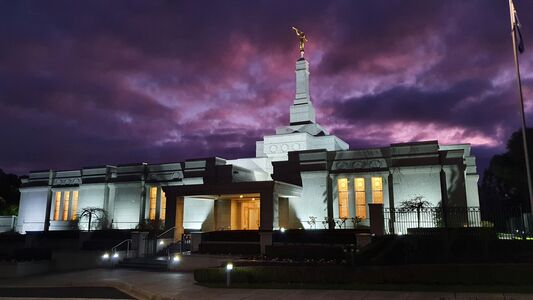Address
756 Pennant Hills RoadCorner Pennant Hills Rd & Moseley St.
Carlingford, New South Wales 2118
Australia
Telephone: (+61) 2-9841-5471
Services
NO visitors' center open to the publicArrival center available
Patron housing available
Distribution center on site (Store Locator)
Announcement:
2 April 1980Groundbreaking and Site Dedication:
13 August 1982 by Bruce R. McConkiePublic Open House:
6–18 September 1984Dedication:
20–23 September 1984 by Gordon B. HinckleyRededication:
24 November 1991 by Russell M. Nelson (addition only)Site:
3 acres | 1.2 hectaresExterior Finish:
Precast panels; white quartz finish; terra cotta roof tilesArchitectural Features:
Single attached end spire with an angel Moroni statueOrdinance Rooms:
Two instruction rooms, three sealing rooms, and one baptistryTotal Floor Area:
30,067 square feet | 2,793 square metersElevation:
418 feet | 127 metersTemple Locale
The Sydney Australia Temple is located in suburban Carlingford, about 12 miles northwest of downtown Sydney. The tranquil setting is considerably beautified by award-winning landscaping including huge eucalyptus trees that perpetuates appealing form and color year round. The temple shares its site with Church area offices and a patron housing facility.
Temple History
The Sydney Australia Temple was the first temple built in Australia.
The Sydney Australia Temple sits on property formerly used as a school for boys. The buildings were renovated and converted for Church use including area offices.
Elder Bruce R. McConkie of the Quorum of the Twelves Apostles—a former mission president of Australia—presided over the groundbreaking services for the Sydney Australia Temple. At a fireside that evening, he said, "There is no reason why we can't have temples in Adelaide, Melbourne, Brisbane, Perth, or wherever the number of saints justifies it." His statement proved prophetic with the construction of the Adelaide Australia Temple, Melbourne Australia Temple, Brisbane Australia Temple, and Perth Australia Temple.
During construction of the Sydney Australia Temple, numerous workers on the project—most of whom did not belong to the Church—asked questions of Brother Frank Hewstone, the Church’s project representative, about the temple. One worker often turned to many by the time he finished providing his explanations.
Thousands of Australians toured the Sydney Australia Temple during its public open house in September 1984, resulting in hundreds of requests for more information about the Church.





